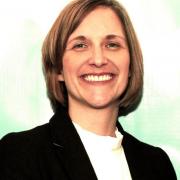
Photo credit: LWA/Dann Tardif/Getty Images.
Making Women's Public Leadership Visible to the Next Generation
I have three young daughters, and like any parent, I am anxious for them to grow up believing they can be anything they want to be – I want them to dream big, as they say. But too often I am reminded that the world hasn’t quite caught up to my expectations. Last year, my oldest daughter learned about composers in her music class. Every month or so, she came home with new information about Beethoven, Bach, or Mozart, among others. One day, she asked me: “Mommy, aren’t there any girl composers?” In all fairness to her music teacher (who is excellent), both history and traditional education curricula have been unkind to women. My daughter and I spent some time online and found information about some lesser known female composers, many of whom would have presumably been more well-known if given the opportunity to shine in their own time.
This experience didn’t particularly surprise me, given my own work at the Center for American Women and Politics (CAWP). When boys or girls open a history textbook in elementary school, for example, they are likely to read about the Founding Fathers of our country or the 43 men who have served as our nation’s president, but not very likely to learn about one of the dozen-plus women who have run for president, or the first women to serve as governors of their states. One research study found that in one of the most commonly-used second-grade textbooks, for example, less than a quarter of the historical figures mentioned are women, and far fewer pages are devoted to these women than to men; the books include up to 5 pages of mentions for women leaders, while the men receive up to 22 pages worth of mentions. It doesn’t get better as students get older; in a popular high school history book, female historical figures are only 13% of those mentioned, and those women are mentioned, at most, on 6 pages, while some of the men are mentioned on as many as 36 pages. Traditionally, women public leaders are absent from the students’ day-to-day learning experience. And this problem of underrepresentation is not unique to history books; it plays out in real life. In 2014, women hold less than a quarter of state legislative seats and are less than 20% of members of Congress.
I worry about my daughters, because if a girl can’t imagine a woman leader, how can she become one? And if a boy sees only men in leadership roles, what will convince him to support aspiring women leaders? CAWP’s newest initiative, Teach a Girl to Lead™ (TAG) is our national campaign to make women’s public leadership visible to the next generation. We want to re-envision what public leaders look like, inspire girls and young women to follow in their footsteps, and make women’s political leadership visible to America’s youth. When young people – both girls like my daughters AND the boys in their classes – learn from an early age that public leaders can look like their mothers, aunts and grandmothers, they grow up with a broader and more inclusionary view of leaders and leadership, and that’s good for all of us.
The TAG site is full of useful resources to help all of us teach young people about women’s leadership and civic engagement.
- Teachers can draw on lessons on women in politics.
- Games and activities help young people better understand the workings of their government and the roles that women play in the process.
- A variety of exercises enhance the capacity of girls and young women for public leadership.
- You can point young people toward our women and politics book list or encourage them to watch a film!
- A Programs & Places Resource Map features girls’ leadership programs, including those with a focus public leadership, as well as coed civic leadership programs; historic sites where women leaders made history; and field trip ideas to show girls and boys about women’s political history.
- The women public leaders in our Leaders Lineup are ready to speak in your classroom or youth meeting, and we provide sample invitation letters and discussion questions.
- We offer tools for examining leaders and leadership through a gender lens.
Follow us on Facebook and Twitter to get our program updates and highlights. Thanks for joining us on this campaign. Our democracy will be stronger if we inspire a new generation of girls and young women to aspire to public leadership and educate all our young people about the important roles of women in our government.
Send us suggestions and follow us for ongoing updates!


The views and opinions expressed in this post are those of the author(s) and do not necessarily reflect those of MomsRising.org.
MomsRising.org strongly encourages our readers to post comments in response to blog posts. We value diversity of opinions and perspectives. Our goals for this space are to be educational, thought-provoking, and respectful. So we actively moderate comments and we reserve the right to edit or remove comments that undermine these goals. Thanks!